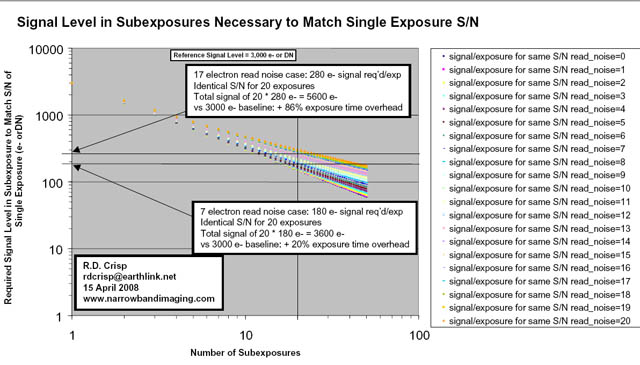Using Multiple Subexposures to Attain the Same S/N
as a Single Exposure
This is a basic task for
all imagers: deciding on how many exposures to take or what exposure length to
use.
Many factors influence the
decision; two basic factors are the signal to be sensed and the read
noise of the camera. These are basic and unavoidable first order parameters
and by restricting our examination to these alone, insight can be gained into
the exposure optimization task.
The basic signal to noise
equation for a flat is what we will be examining. It can be shown that the S/N
of a low contrast image is equal to the S/N of a flat field image when the
average signal levels are the same and more specifically:
S/N(image) = M*S/N(flat
field) where M is the modulation factor of the image.
This teaches that
optimizing the S/N of a flat field image produces the highest S/N for an
image.
Since flat field images are convenient
to take and to analyze they provide an important tool for image S/N
optimization.
For this analysis we are
ignoring the noise associated with dark signal formation. This is easily
justified by noting that cooling can be used to set the dark current at a
level that creates insignificant noise during the period of the exposure.
Insignificant noise means it is more than a factor of 10 less than
the read noise of the camera. So we will ignore dark noise and dark fixed
pattern noise.
Fixed pattern noise is
ignored because it can be removed by flat-fielding. While it may seem silly to
apply a flat to a flat, from a noise analysis perspective it makes perfect
sense. So we will ignore fixed pattern noise.
The remaining significant
noise sources are the shot noise of the signal itself ( =sqrt(signal)) and the
read noise of the camera.
The S/N equation works out
to be = Signal / Sqrt(Signal + rd_noise^2). This is what will be analyzed.
For an exposure comprised
of K subexposures of Signal/K, the noise becomes
Signal / Sqrt(Signal + K*rd_noise^2)
If the rd_noise is non-zero
then 10 exposures of n seconds will give a lower s/n ratio than a single
exposure of 10*n seconds looking solely at these parameters. How much lower
depends on the relative magnitude of the signal shot noise and the read noise.
With non-zero read noise the S/N will be
degraded when multiple subexposures are summed compared to a single exposure of the
same total time. For the multiple subexposure case, it is possible to match
the S/N of the single exposure case by increasing
the subexposure time or by picking a subexposure time and adjusting the number
of exposures.
The purpose of this
analysis is to derive a relationship for K subexposures of time Tk
that provides the same S/N as a single exposure of a lesser time T. A second
purpose of this analysis is to derive an expression for N subexposures of
chosen level K such that the resulting S/N ratio is the same as a single
exposure. So one way picks the number of exposures and calculates the exposure
level necessary, while the other picks the exposure level and calculates the
number of exposures to reach the same S/N as the single exposure.

Click to read report

